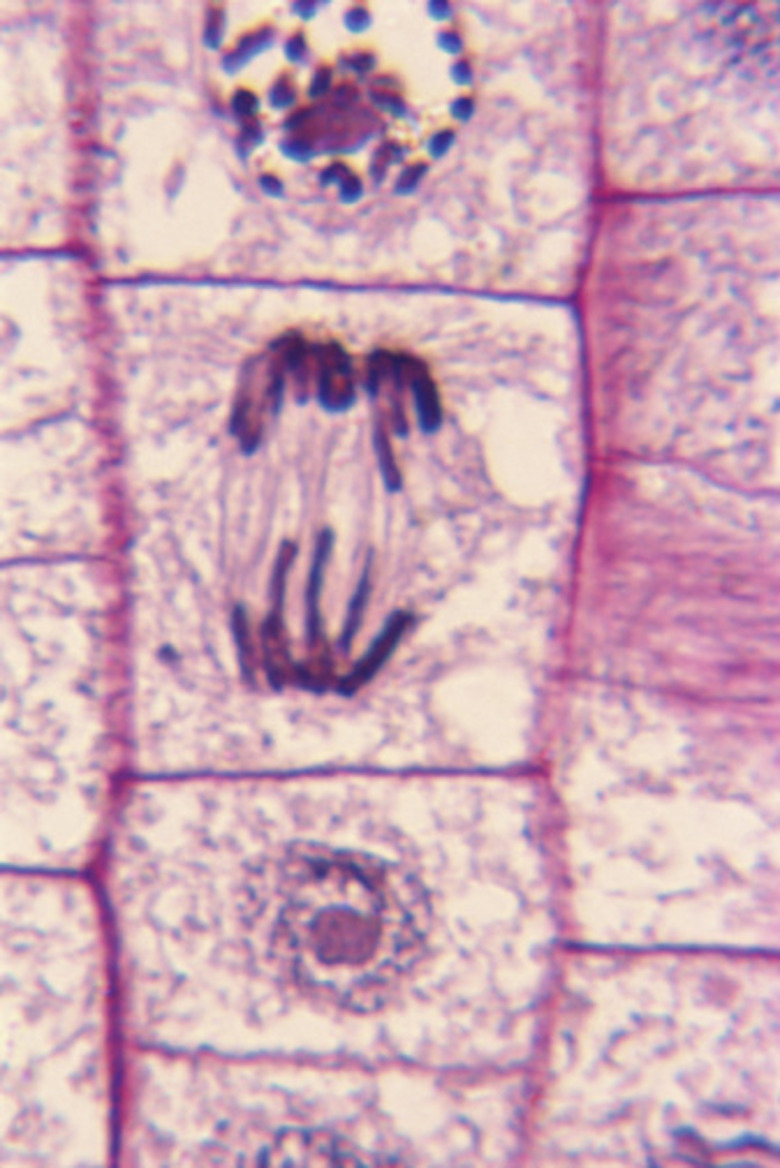Two Types Of Cell Division Cycles
Cellular reproduction follows one of two types of cell division cycles: mitosis or meiosis.
A cell reproducing through mitosis splits in two following a series of steps that lead to the creation of two identical daughter cells. Only one cell is required to reproduce in this manner and all cells created through mitosis are copies of the original mother cell, which serves as a basic cell division definition.
Meiosis, however, involves a longer process that allows for the creation and joining of sperm and egg cells. Meiosis produces the cells required to create a new organism that differs genetically from both parent organisms.
Two Kinds of Cell Division
Two Kinds of Cell Division
Single-celled organisms that reproduce asexually, such as bacteria and algae, undergo mitosis. The organism replicates its DNA and divides in two, distributing one copy to each of the two new daughter cells. Mitosis occurs in more complex organisms as a way to repair and replace damaged cells and to allow growth, such as the formation of new skin, hair or muscle cells.
Meiosis, which produces sperm and egg cells necessary for sexual reproduction, occurs in all eukaryotic organisms including animals and plants. Meiosis requires two full cycles. During the first meiosis cycle, referred to as meiosis I, the parent cell splits into two daughter cells, each with a full set of chromosomes.
The daughter cells then undergo the second cycle of meiosis, meiosis II. During the second cycle, each daughter cell splits in two, creating a total of four haploid cells that each contain half of the genetic material necessary to create a new organism.
Understanding Mitosis
Understanding Mitosis
A cell undergoing mitosis goes through six steps, or phases:
1. Interphase 2. Prophase 3. Metaphase 4. Anaphase 5. Telophase 6. Cytokinesis
In the first step, interphase, the mother cell grows, develops and duplicates each chromosome. The chromosomes contain genetic material, or DNA.
During prophase, the newly copied chromosomes pair up and stick together to form sister chromatids. The membrane of the nucleus, which usually contains the chromosomes, dissolves to allow the chromatids to shift and polar fibers form like threads anchoring the chromatids to opposite poles within the cell.
During metaphase, the chromatids line up along the cell's equator. Their polar fibers have fully formed and hold the chromatids in position. In anaphase, the chromatids separate into their sister chromosomes. As each chromosome separates from its copy, the polar fibers slowly draw the chromosomes toward the poles of the cell.
During telophase, the cell forms two new nuclear membranes around the two identical groupings of chromosomes. The cell elongates and the cellular membrane prepares to split.
Cytokinesis is the final step of mitosis, in which the membrane of the elongated cell begins to pinch together along the cell's equator until the membranes meet. The two halves then separate from each other, forming two new daughter cells, identical to the mother cell.
Meiosis I
Meiosis I
Plants, animals and other organisms that reproduce sexually use meiosis to create their reproductive cells, allowing for genetic diversity that is not possible through mitosis. Two distinct cycles, or divisions, are required during meiosis. As with mitosis, the first cycle, meiosis I, flows through six steps:
1. Interphase I 2. Prophase I 3. Metaphase I 4. Anaphase I 5. Telophase I 6. Cytokinesis I
During interphase I, a somatic cell, or cell that has two sets of chromosomes, copies its DNA. In prophase I, the homologous, or matching, chromosomes match up to form pairs called bivalents or tetrads. Each bivalent has two chromosomes, one each from the organism's mother and father, and four chromatids. The nuclear membrane begins to dissolve.
During metaphase I, the bivalents line up along the cell's equator. The direction they face is random so there is a 50:50 chance of each daughter cell receiving a chromosome containing DNA of the mother or father of the organism.
Next, in anaphase I, the chromosome pairs separate and are pulled toward either pole, but each chromosome still retains two chromatids. Telophase I begins as nuclear membranes form around each set of chromosomes. Some cells then undergo cytokinesis I and split into two separate sister cells, though in many animals, the sister cells do not separate completely before beginning meiosis II.
Meiosis II
Meiosis II
During meiosis II, both of the daughter cells formed during meiosis I undergo a five-step division cycle including:
1. Prophase II 2. Metaphase II 3. Anaphase II 4. Telophase II 5. Cytokinesis II
Interphase is skipped because this second division is not designed to create copies, but rather to split the two chromatids of each chromosome and prepare the cells for sexual reproduction. During prophase II, the newly formed nuclear membranes begin to dissolve and the pairs of chromatids begin drifting into place.
In metaphase II, the paired chromatids align along the equators of each daughter cell while the polar fibers form an anchor them in place. During anaphase II, the chromatids of each chromosome separate and are drawn toward separate poles. Telophase II then begins with nuclear membranes forming around each set of chromosomes.
Finally, cytokinesis II occurs. The cellular membranes begin to pinch together and both of the daughter cells split into two for a total of four haploid cells whose chromosomes only have one chromatid. Both egg and sperm cells are haploid cells created through meiosis.
When the two haploid cells combine, the chromatids of corresponding chromosomes match up to provide the genetic material necessary to create a new organism.
Cite This Article
MLA
Ramirez, Jennifer. "Two Types Of Cell Division Cycles" sciencing.com, https://www.sciencing.com/two-types-cell-division-cycles-8440937/. 13 March 2019.
APA
Ramirez, Jennifer. (2019, March 13). Two Types Of Cell Division Cycles. sciencing.com. Retrieved from https://www.sciencing.com/two-types-cell-division-cycles-8440937/
Chicago
Ramirez, Jennifer. Two Types Of Cell Division Cycles last modified March 24, 2022. https://www.sciencing.com/two-types-cell-division-cycles-8440937/
